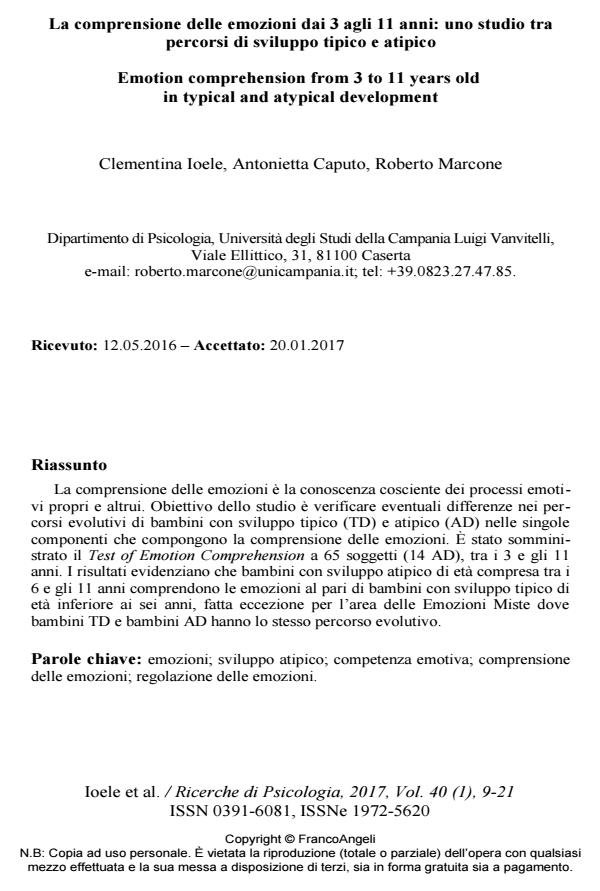La comprensione delle emozioni dai 3 agli 11 anni: uno studio tra percorsi di sviluppo tipico e atipico
Titolo Rivista RICERCHE DI PSICOLOGIA
Autori/Curatori Clementina Ioele, Antonietta Caputo, Roberto Marcone
Anno di pubblicazione 2017 Fascicolo 2017/1
Lingua Italiano Numero pagine 13 P. 9-21 Dimensione file 217 KB
DOI 10.3280/RIP2017-001001
Il DOI è il codice a barre della proprietà intellettuale: per saperne di più
clicca qui
Qui sotto puoi vedere in anteprima la prima pagina di questo articolo.
Se questo articolo ti interessa, lo puoi acquistare (e scaricare in formato pdf) seguendo le facili indicazioni per acquistare il download credit. Acquista Download Credits per scaricare questo Articolo in formato PDF

FrancoAngeli è membro della Publishers International Linking Association, Inc (PILA)associazione indipendente e non profit per facilitare (attraverso i servizi tecnologici implementati da CrossRef.org) l’accesso degli studiosi ai contenuti digitali nelle pubblicazioni professionali e scientifiche
La comprensione delle emozioni è la conoscenza cosciente dei processi emotivi propri e altrui. Obiettivo dello studio è verificare eventuali differenze nei percorsi evolutivi di bambini con sviluppo tipico (TD) e atipico (AD) nelle singole componenti che compongono la comprensione delle emozioni. È stato somministrato il Test of Emotion Comprehension a 65 soggetti (14 AD), tra i 3 e gli 11 anni. I risultati evidenziano che bambini con sviluppo atipico di età compresa tra i 6 e gli 11 anni comprendono le emozioni al pari di bambini con sviluppo tipico di età inferiore ai sei anni, fatta eccezione per l’area delle Emozioni Miste dove bambini TD e bambini AD hanno lo stesso percorso evolutivo.
Parole chiave:Emozioni; sviluppo atipico; competenza emotiva; comprensione delle emozioni; regolazione delle emozioni.
- Assessing the Factor Structure and Measurement Invariance of the Test of Emotion Comprehension (TEC): A Large Cross-Sectional Study with Children Aged 3-10 Years Valeria Cavioni, Ilaria Grazzani, Veronica Ornaghi, Alessandro Pepe, Francisco Pons, in Journal of Cognition and Development /2020 pp.406
DOI: 10.1080/15248372.2020.1741365
Clementina Ioele, Antonietta Caputo, Roberto Marcone, La comprensione delle emozioni dai 3 agli 11 anni: uno studio tra percorsi di sviluppo tipico e atipico in "RICERCHE DI PSICOLOGIA " 1/2017, pp 9-21, DOI: 10.3280/RIP2017-001001